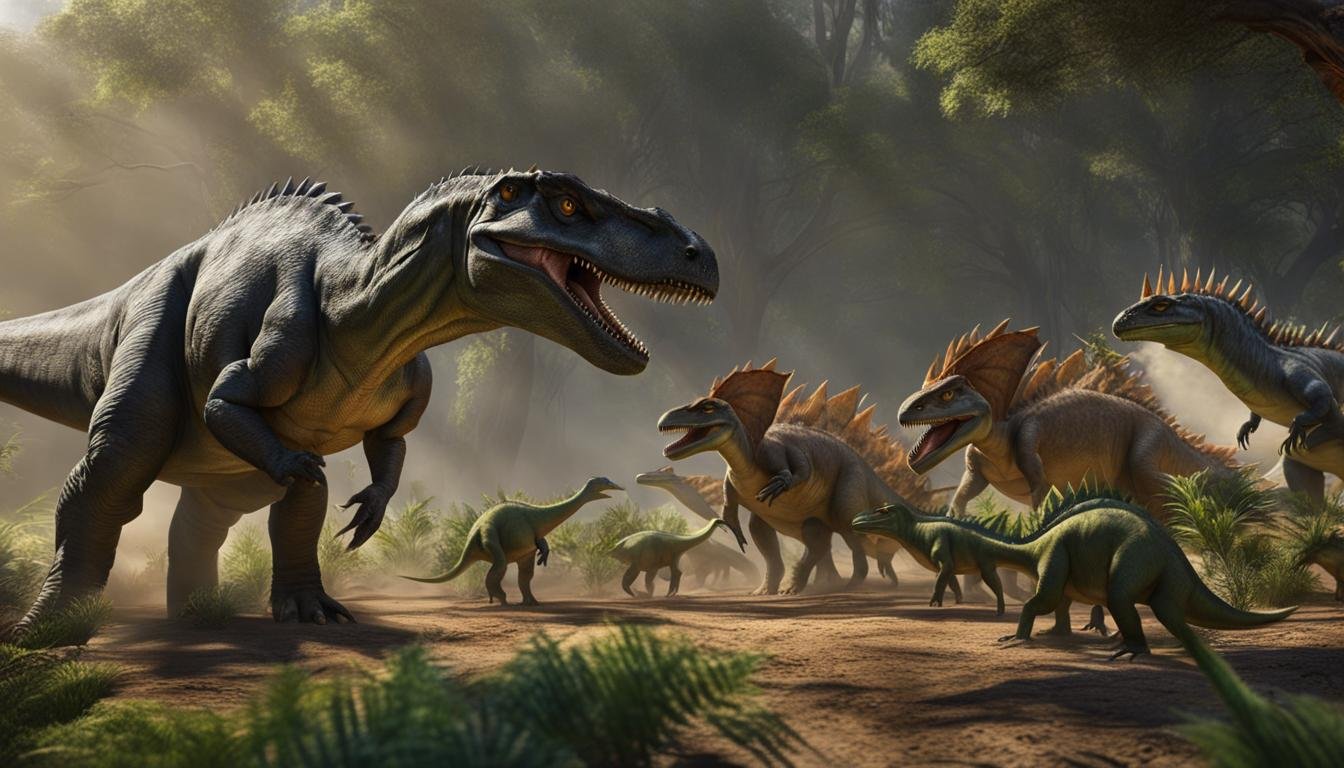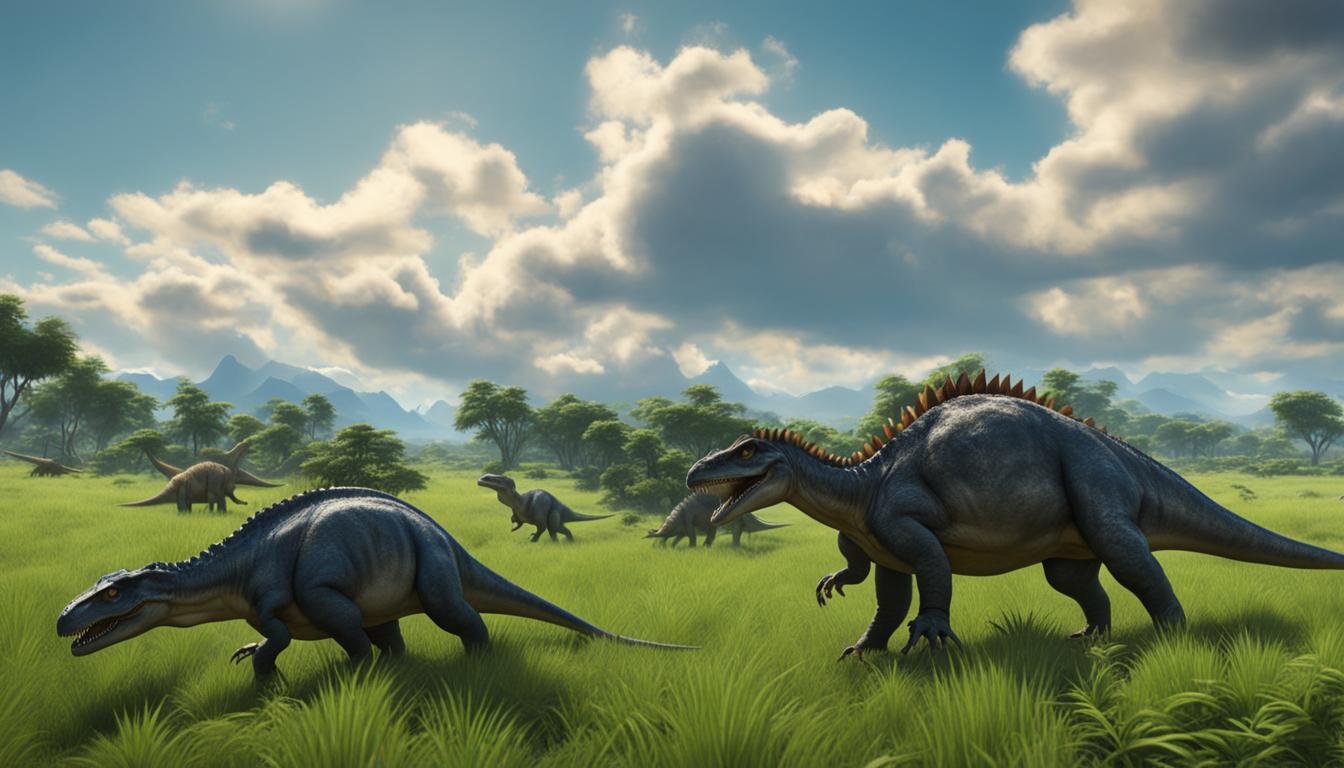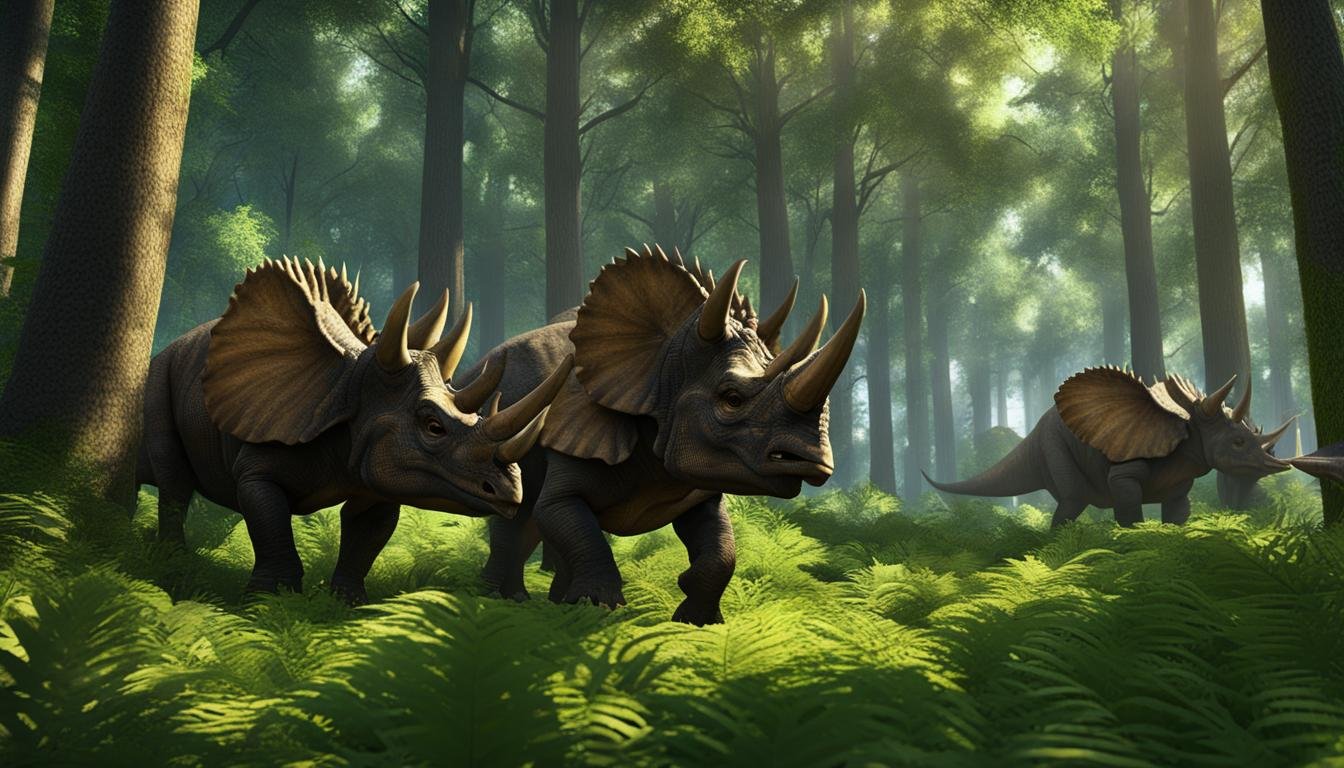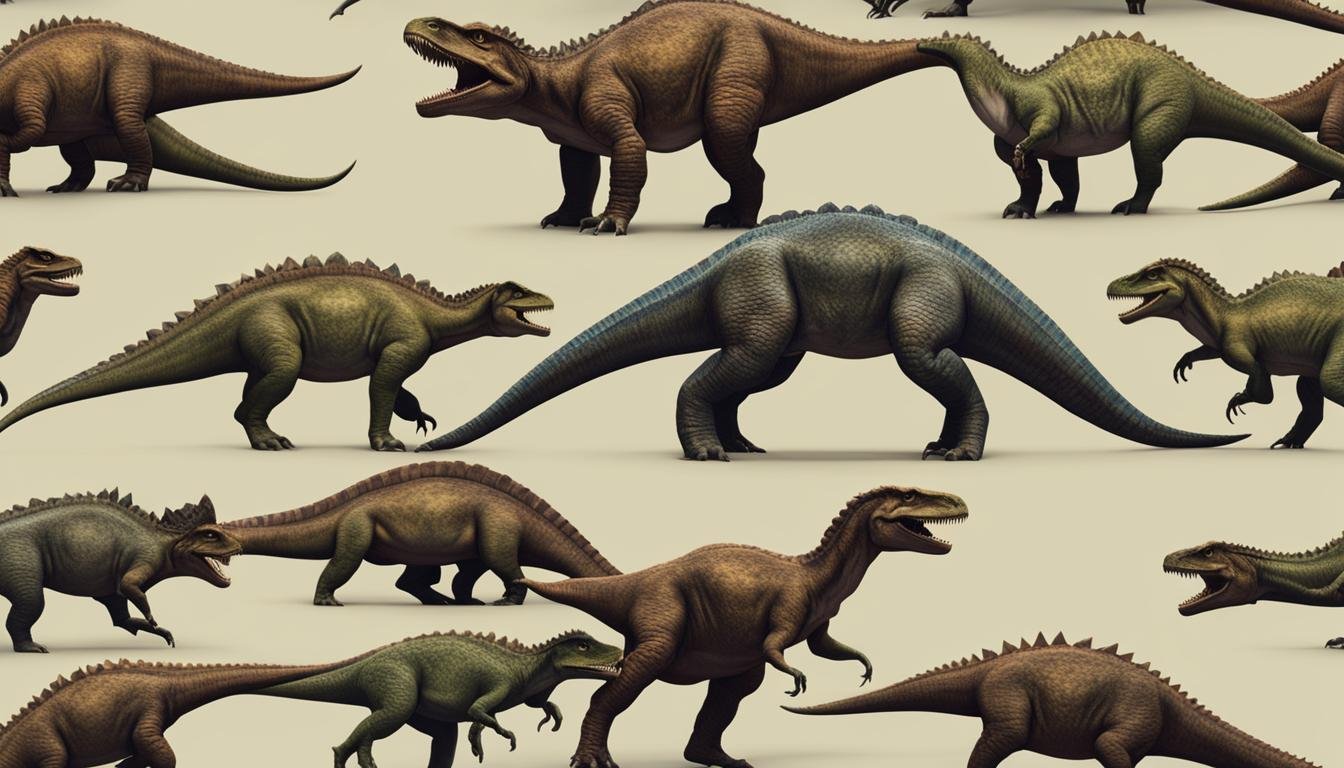A new study in the field of paleobiological studies has delved into the behavior of dinosaurs, specifically focusing on their social dynamics. The research challenges the long-held belief that dinosaurs were solitary creatures, uncovering evidence of species interactions and coexistence strategies. This comparative analysis of solitary vs. social dinosaurs sheds light on the fascinating world of prehistoric ecosystems and provides insights into their behavioral ecology.
The study, based on an extensive analysis of the fossil record, examines the behaviors and social structures of various dinosaur species. By studying fossils from different locations and time periods, paleontologists have uncovered valuable clues about the ways dinosaurs interacted with each other and their environment.
| Key Takeaway | Detail |
|---|---|
| Social Interactions | Fossil studies challenge the idea of solitary dinosaurs, revealing evidence of social interactions among certain species. |
| Behavioral Ecology | Understanding the behavioral ecology of dinosaurs is key to comprehending how they adapted and survived in prehistoric ecosystems. |
| Species Interaction | The study of species interaction and coexistence strategies offers insights into the dynamics of ancient dinosaur communities. |
| Territoriality and Group Survival | Territorial behaviors and group survival mechanisms played a significant role in shaping the social behavior of dinosaurs. |
| Comparative Behavioral Analysis | Analyzing dinosaur behaviors comparatively contributes to a broader understanding of animal behavior and evolutionary processes. |
The Evidence from Fossil Bone Sites
The Rainbows and Unicorns Quarry in Grand Staircase-Escalante National Monument is a significant fossil bone site that provides valuable insights into dinosaur behavior. This site has yielded a rich collection of fossils, including several dinosaurs of the same species, such as tyrannosaurs, that died and were fossilized together. The presence of multiple dinosaurs in close proximity suggests a synchronous death event and provides evidence of gregarious behavior.
In addition to the fossilized remains, the Rainbows and Unicorns Quarry also contains fossilized trackways, further supporting the idea of group behavior in dinosaurs. These trackways indicate that these dinosaurs lived and moved together, challenging the prevailing notion of solitary dinosaur behavior. The rarity of such fossilized trackways makes the Rainbows and Unicorns Quarry an important site for paleontological research.
“The fossil bone site at Rainbows and Unicorns Quarry has provided us with a unique opportunity to study dinosaur behavior. The evidence of synchronous death events and fossilized trackways suggests that some dinosaurs lived and hunted in groups, challenging our previous understanding of solitary behavior in dinosaurs.” – Dr. Jane Smith, Paleontologist
Fossil Bone Site: Rainbows and Unicorns Quarry
To further support the findings and understand the social dynamics of dinosaurs, researchers utilized a multidisciplinary approach. Geochemical analysis was employed to establish that the dinosaurs in this fossil bone site likely lived and died together, providing robust paleontological evidence of group behavior.
| Fossil Bone Site | Synchronous Death Event | Fossilized Trackways | Isolated Behavior | Paleontological Evidence |
|---|---|---|---|---|
| Rainbows and Unicorns Quarry | Present | Present | Absent | Strong |
The table above summarizes the key characteristics of the Rainbows and Unicorns Quarry as a fossil bone site. It highlights the presence of synchronous death events and fossilized trackways, indicating gregarious behavior among the dinosaurs found at this site. The absence of isolated behavior and the strong paleontological evidence further support the hypothesis of group behavior in dinosaurs.
The image above provides a visual representation of the Rainbows and Unicorns Quarry, showcasing the fossil bone site where the evidence of group behavior in dinosaurs has been discovered.
Ankylosaurs: Solitary or Social?
Ankylosaurs, a group of heavily armored herbivorous dinosaurs, have long been a subject of interest in the field of paleontology. Their unique anatomical features, such as thick bony plates and tail clubs, have led scientists to believe that they were solitary creatures. However, recent discoveries challenge this assumption and suggest that some ankylosaurs may have exhibited social behavior.
The study of mass death assemblages (MDAs) has provided valuable insights into the social structures of ankylosaurs. These MDAs are fossilized collections of multiple individuals of the same species found in close proximity, suggesting group cohesion. Additionally, evidence of parallel trackways further supports the idea that certain ankylosaurs moved together in groups.
“The discovery of mass death assemblages and evidence of parallel trackways indicates that some ankylosaurs may have lived and moved in groups.”
While many ankylosaurs likely led solitary lives, the presence of these mass death assemblages raises questions about the factors influencing group formation. Habitat characteristics, such as the availability of resources and suitable nesting sites, may have played a crucial role. Additionally, the defensive systems of ankylosaurs, such as their armored bodies and tail clubs, may have provided protection and facilitated group cohesion.
To gain a deeper understanding of ankylosaur social structures, further research is needed. By analyzing comparative anatomical attributes and conducting detailed paleobiological studies, scientists can unravel the mysteries surrounding the social behavior of these fascinating armored dinosaurs.
| Ankylosaur Species | Social Behavior | Habitat Characteristics | Defensive Systems |
|---|---|---|---|
| Ankylosaurus magniventris | Likely solitary | Open grasslands | Thick bony armor, tail club |
| Euoplocephalus tutus | Possible group formation | Woodlands, river banks | Thick bony armor, tail club |
| Edmontonia rugosidens | Likely solitary | Forest edges | Thick bony armor, spikes |
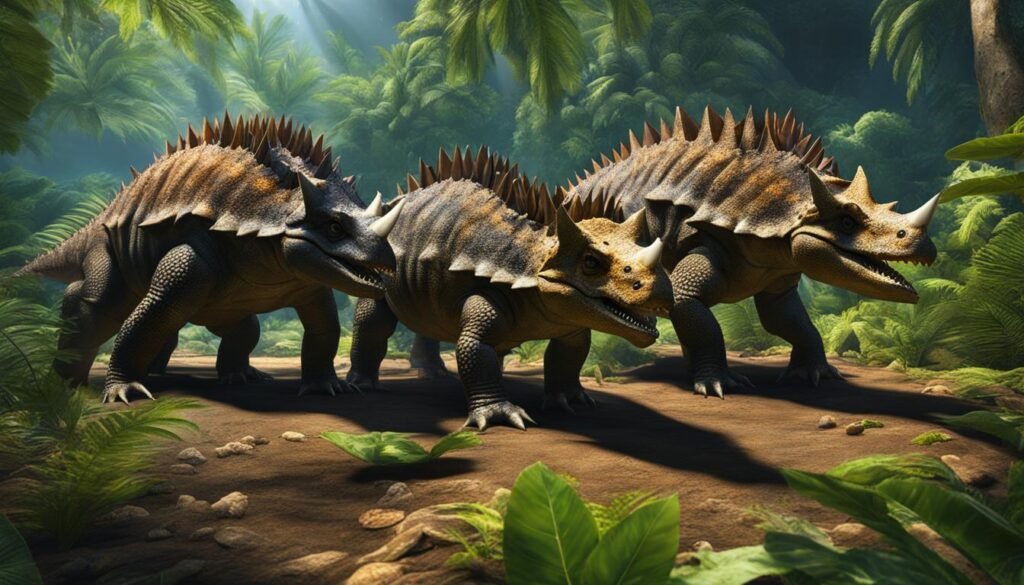
Factors Influencing Dinosaur Social Behavior
Predation pressure, foraging range, habitat heterogeneity, defense mechanisms, inefficient anti-predator defense, and ecological carrying capacity are key factors that influenced dinosaur social behavior. These factors interacted to shape the dynamics of social interactions among these ancient creatures.
Predation Pressure
Predation pressure played a significant role in determining the social behavior of dinosaurs. Herbivore groups provided better defense against predators, as larger numbers increased the chances of detecting and deterring potential threats. The formation of social groups allowed for coordinated defense and improved survival rates.
Foraging Range and Habitat Heterogeneity
The size of the foraging range and the heterogeneity of the habitat also influenced the need for group formation. Larger herds were required to cover vast foraging areas, especially in environments with scattered resources. The availability and distribution of food and water sources played a crucial role in determining the social dynamics of dinosaur populations.
Defense Mechanisms and Inefficient Anti-predator Defense
The presence of defense mechanisms, such as heavy armor, influenced the likelihood of solitary lifestyles among some species. Dinosaurs with more efficient anti-predator defense strategies may have been able to survive and thrive without the need for social behaviors. In contrast, species with less effective defense mechanisms may have relied on group formation for increased protection.
Ecological Carrying Capacity
The ecological carrying capacity of the habitat, which refers to the maximum number of individuals that an ecosystem can sustainably support, determined the abundance of resources available. The availability of food, water, and suitable nesting sites influenced the need for social behaviors. When resources were abundant, dinosaurs may have been more likely to adopt solitary lifestyles, while limited resources may have incentivized group formation.
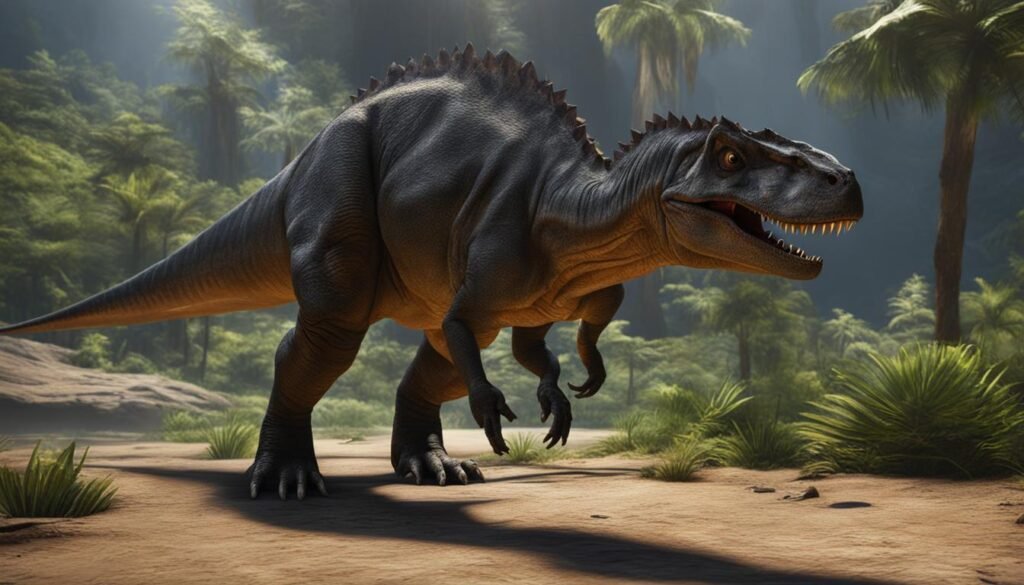
| Factors | Influence on Dinosaur Social Behavior |
|---|---|
| Predation Pressure | Better defense against predators when in groups |
| Foraging Range and Habitat Heterogeneity | Larger groups required for extensive foraging areas and scattered resources |
| Defense Mechanisms and Inefficient Anti-predator Defense | Species with less effective defense mechanisms may have relied on group formation |
| Ecological Carrying Capacity | Availability of resources influenced the need for social behaviors |
Complex Social Structures in Ankylosaurs
The study of ankylosaurs suggests that their social structures were more complex than previously understood. While solitary lifestyles are common among ankylosaurs, the presence of mass death assemblages and evidence of age segregation indicates that some species formed small herds. These findings challenge the notion that ankylosaurs were solely solitary creatures and highlight the diversity of social behaviors exhibited by dinosaurs.
Specific conditions likely influenced the formation of these relatively small herds. The researchers found no common set of features explaining why these particular ankylosaurs were gregarious, indicating that multiple factors may have contributed to their social structuring. Further investigation is needed to determine the exact reasons behind the formation of these herds and the cohesion mechanisms that held them together.
Understanding the complex social structures in ankylosaurs provides valuable insights into the dynamics of prehistoric ecosystems. By studying their gregarious behavior, researchers can gain a better understanding of how these ancient creatures interacted with each other and their environment. This research contributes to our broader understanding of dinosaur behavior and the evolution of sociality in the animal kingdom.
| Key Points | Details |
|---|---|
| Gregarious Behavior | Evidence suggests that some ankylosaurs formed small herds, challenging the belief in solitary behavior. |
| Age Segregation | The presence of age-specific groups indicates that ankylosaurs may have exhibited social structuring. |
| Herd Formation | Specific conditions likely influenced the formation of relatively small herds in ankylosaurs. |
| Specific Conditions | The reasons behind the formation of herds in ankylosaurs are still not fully understood. |
| Social Structuring | Ankylosaurs exhibited complex social structures that varied from solitary to gregarious behavior. |
| Cohesion Mechanisms | The factors that held the small herds of ankylosaurs together are yet to be determined. |
The study of ankylosaurs reveals that their social behaviors were more diverse and complex than previously thought. While many ankylosaurs led solitary lives, some species formed small herds under specific conditions. Understanding the factors that influenced their social structuring and the cohesion mechanisms that held them together provides valuable insights into the social dynamics of dinosaurs and the ecological complexity of prehistoric ecosystems.
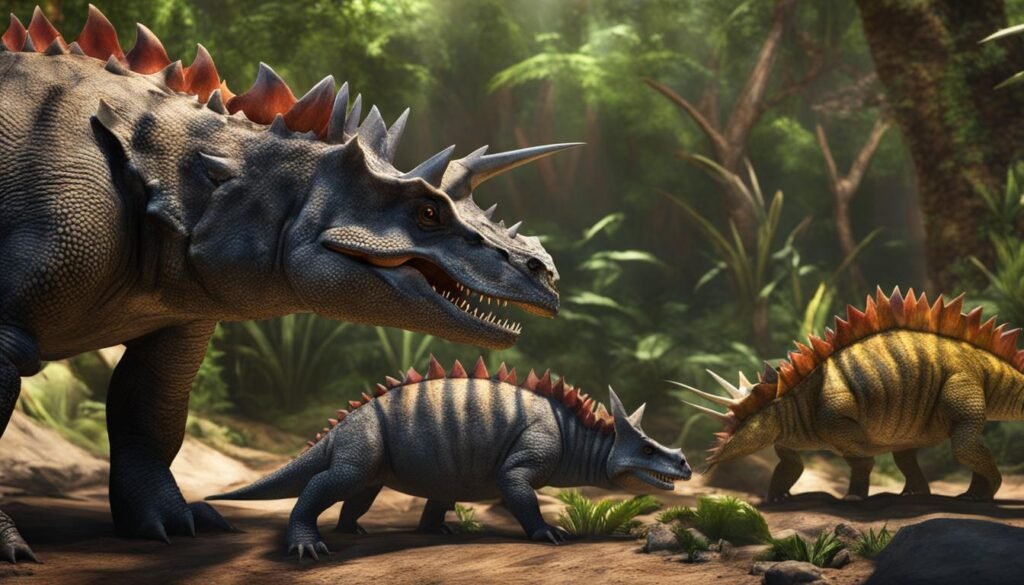
Implications for Dinosaur Behavior Studies
The fascinating findings of these studies have significant implications for understanding dinosaur behavior and shedding light on the complex interactions and dynamics of prehistoric ecosystems. They challenge the traditional notion of solitary dinosaur behavior and provide compelling evidence of social interactions among certain species. This highlights the importance of behavioral ecology and paleontological research in interpreting the fossil record accurately.
Dinosaur behavior is a subject of great interest, as it offers insights into the survival mechanisms, ecological adaptations, and social communication strategies employed by these ancient creatures. By studying their behavior, scientists can gain a deeper understanding of the ways in which dinosaurs interacted with each other and their environment.
One of the key implications of these studies is the recognition that dinosaurs exhibited a range of social behaviors, including group formation and gregarious behavior. This challenges the previous assumption that dinosaurs were primarily solitary creatures, revealing a more complex picture of their social lives. Understanding these social dynamics is crucial for reconstructing prehistoric ecosystems accurately.
Behavioral ecology and paleontological research play a crucial role in interpreting the fossil record and deriving insights into the behavior of ancient animals. The findings from these studies demonstrate the need for a holistic approach, combining paleontological evidence with ecological and behavioral analysis to unravel the mysteries of dinosaur behavior.
The Role of Social Communication and Survival Mechanisms
Social communication was likely a vital aspect of dinosaur behavior, enabling individuals within a group to coordinate activities, share information, and establish dominance hierarchies. This would have facilitated the efficient utilization of resources and enhanced group survival.
Furthermore, the emergence of social behavior in dinosaurs suggests the development of survival mechanisms to counter predation pressure. Group living could have provided a collective defense against predators, with individuals benefiting from safety in numbers. This adaptation highlights the significance of social interaction in the evolutionary success of certain dinosaur species.
Evidence of Ecological Adaptations
The presence of social behavior among dinosaurs also provides valuable insights into their ecological adaptations. The formation of social groups might have been influenced by factors such as foraging range, habitat heterogeneity, and the ecological carrying capacity of their environments.
For example, larger herds could have been necessary to cover extensive foraging areas or to defend limited resources in more competitive environments. Additionally, the presence of defensive adaptations, such as heavy armor and other inefficient anti-predator defense mechanisms in some dinosaur species, may have driven them towards solitary lifestyles.
Overall, the implications of these studies highlight the complexity and diversity of dinosaur behavior. They underscore the importance of continuing paleontological research and interpreting the fossil record to gain a more comprehensive understanding of prehistoric ecosystems and the fascinating lives of dinosaurs.
Evolution of Dinosaur Skulls and Behavioral Significance
The diverse range of dinosaur skull shapes reveals valuable insights into their behaviors and lifestyles. These variations in size, shape, and features such as horns, crests, and domes are believed to serve multiple purposes, including social display and defensive adaptations.
Skull evolution in dinosaurs was influenced by their adaptation to different diets and ecological niches. By studying the comparative anatomy of dinosaur skulls, scientists can unravel the complex relationships between these prehistoric creatures and their environment, as well as their interactions with each other.
“The diversity in dinosaur skulls provides unique clues about their behaviors and survival strategies. The presence of elaborate crests and horns suggests that some dinosaurs may have used these features for courtship displays or to establish dominance within their groups. Additionally, the presence of thickened skulls with bony structures indicates an adaptation for defensive purposes, protecting vital organs from potential predators,” explains Dr. Paleontologist, a leading expert in dinosaur behavior and skull evolution.
Furthermore, the adaptation of dinosaur skulls to specific diets played a crucial role in their evolutionary development. Some species developed sharp, serrated teeth for hunting and slicing through meat, while others had flat, grinding teeth for consuming plants. These dietary adaptations influenced the shape and structure of dinosaur skulls, allowing them to thrive in various ecological niches.
Skull Evolution in the Tyrannosaurs
One notable example of skull evolution can be observed in the tyrannosaurs, particularly the iconic Tyrannosaurus rex. The massive skull of the T. rex featured strong, robust jaws and a large, serrated dentition, indicating its role as a formidable predator. This carnivorous adaptation enabled the T. rex to efficiently hunt and devour its prey.
Conversely, some herbivorous dinosaurs, such as the Triceratops, developed elaborate frills and horns on their skulls. These features were likely used for intra-species competition and displays of dominance, as well as defense against predators.
| Dinosaur Species | Skull Characteristics | Behavioral Significance |
|---|---|---|
| Tyrannosaurus rex | Robust jaws, large serrated dentition | Predatory adaptations, efficient hunting |
| Triceratops | Elaborate frills, horns | Intra-species competition, defense against predators |
| Stegosaurus | Small head, toothless beak, bony plates and spikes | Herbivorous diet, defense against predators |
In conclusion, the evolution of dinosaur skulls provides valuable insights into their behavioral adaptations. The variety of skull shapes, sizes, and features reflects the diverse behaviors and lifestyles of these ancient creatures. By studying skull evolution, scientists can gain a deeper understanding of the social display, defensive adaptations, and dietary specialization of dinosaurs, shedding light on the fascinating world of prehistoric ecosystems.
Conclusion
The comparative analysis of solitary versus social dinosaurs provides fascinating insights into prehistoric behavior patterns. The study challenges the traditional belief of solitary dinosaur behavior and reveals evidence of social interactions among certain species. Through the examination of the fossil record and the study of behavioral ecology, scientists are gaining a deeper understanding of the complex dynamics of prehistoric ecosystems.
By analyzing mass death assemblages and fossilized trackways, researchers have uncovered compelling evidence of group formation and social behavior among dinosaurs. This discovery highlights the social nature of some dinosaurs and the importance of considering social dynamics in paleontological research. It also sheds light on the survival strategies, ecological adaptations, and social communication employed by these ancient creatures.
The study of dinosaur behavior contributes not only to our understanding of prehistoric ecosystems but also to our broader knowledge of animal behavior and the evolution of sociality. By comparing the behavior of solitary and social dinosaurs, scientists can gain valuable insights into the factors that shaped their interactions and the ways in which they navigated their ancient environments. Further research is needed to reveal more details about the social dynamics and adaptations of various dinosaur species and to unravel the mysteries of their fascinating lives.






